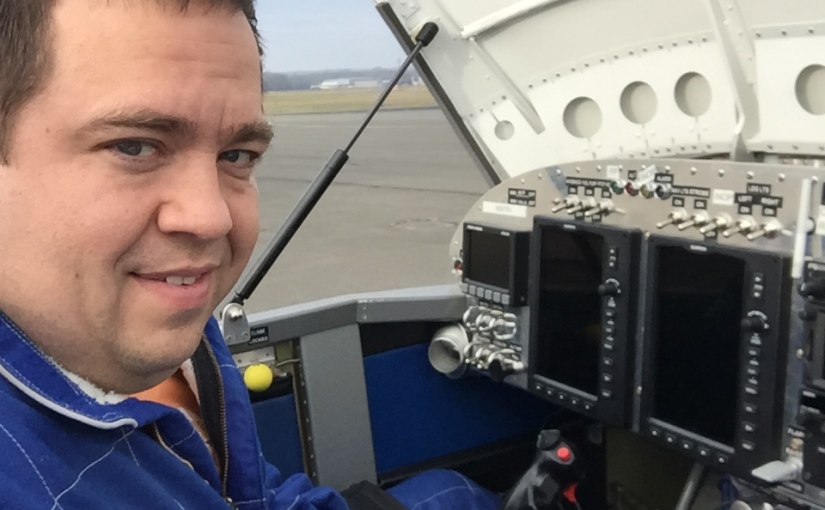Pre-flight prep work: Dave Haschart met me at the hanger at 07:00 and helped with preflight; Thanks Dave! Removed upper & lower cowl, inspect FWF. New heat scat tube mounting looks to be doing well. Reinstalled upper & lower cowl. Attached tape to front cowl noses to see if it helps with not pressurizing the lower cowl area and improves CHTs. Also added tape to block 1/4 of the oil cooler. Tire pressures: L: 32.0, R:31.5, N:31.0. Preflight inspection completed.
I flew four laps around the pattern and performed 3 landings with 15 degrees flap and 1 landing with 30 degrees flap. This plane lands beautifully. I haven’t had a bad landing yet or even so much as a hop/skip, but I’m sure they are coming. The winds have always been calm so far. My takeoffs / go arounds however still leave much to be desired. I haven’t mastered keeping the nose wheel off the ground but not WAY off the ground. Thus when I accelerate on the go after a landing, I either lift off early or let the nose wheel touch. I’m trying to work on getting the hang of the right amount of stick back pressure.
After the 4th landing, when retracting the flaps, I got a red flap fault warning. I taxied back to the hangar to check things out. After shutdown, I reset the flap fault on the VPX (it was a flap runaway; which means the flap motor ran longer than it was supposed to). Turns out it was the up limit on the flap sensor that wasn’t being met, and the flaps kept running when I retracted them. This was the same condition that Mark Gramann noticed on the flap down side, which I corrected earlier by adjusting the down flap limit. It looks like I will need to adjust the up flap endpoint also. I should use this as an opportunity to check that the installation of the flap sensor is not shifting and to permanently install the pop rivets holding the flap sensor.
Post flight 5: Found overflowed brake fluid around the firewall reservoir (will continue to watch this and see if it stops when the reservoir is 1/2 full). Also found some weeping brake fluid connections on the pilot and passenger right brake pedal master cylinder lower connections. I don’t have the best luck with NPT fittings I guess. I have used Locktite 567 when screwing the 90 degree elbows into the gold brake pedal master cylinders, but was afraid of turning them in too hard and probably undershot. I plan to tighten these two fittings and apply Locktite 567 again. Unfortunately, I will have to bleed at least the right side brakes again.
Engine Total Time 6.3, Total Time 7.5, This flight: 0.5/0.7. Oil was at 6.0 quarts (hot). Left tank dipstick was at 16.5, and fuel totalizer said 3.7 used, but I did not fuel or reset totalizer after this flight.
12/13/15: Riveted flap sensor in place. Adjusted the flap up and down stops to be 8 units backed off from actual end points. Adjusted the flaps to run for 0.2 seconds after reaching the backed off stops. This should ensure the stops get triggered and the flaps stop running after an additional 0.2 seconds. Prior to last flight I reversed this roll trim end points so the indicator was indicating properly, but since I didn’t reverse the motor polarity, now the trim indication was moving in the opposite direction of the hat switch. I reversed the motor polarity after this flight, and now finally I think the trim will be running in the correct direction. I also added new baffling extending forward a few more inches on cylinder #1 and #2 towards the top cowl front.

Just came to your site Jim after seeing the post on VAF. Might want to do a search on tire pressure on VAF…most seem to recommend a bit more than what you’re using. You are a very thorough guy and I liked what I could see of your panel. I have a 7-A that was finished in 2013 and which I keep at W24 over here in Lynchburg, VA.
Be safe and come visit sometime.
LikeLike
Thanks Chuck. I’ll be sure to read up on tire pressure. I’ll keep a visit in mind as I get closer to the end of my flight test program. Thanks for the offer. I’ll try to get some better panel pictures up.
Jim
LikeLike
Congratulation on your rv! I don’t even have tools… yet 😦 I have been reading that you need 3 hp 60 Gallon Air Compressor to power air tools what about rovet gun will that be enough? https://www.drillselect.com/forum/power-and-hand-tools/pneumatics/74-60-gallon-air-compressor
LikeLike
Thanks.
That aircompresor looks a lot like the one I have from Lowes. Be sure to get one that is oil filled…the oilless ones seem small/weak and prone to overheating. I think that should do you fine.
LikeLike